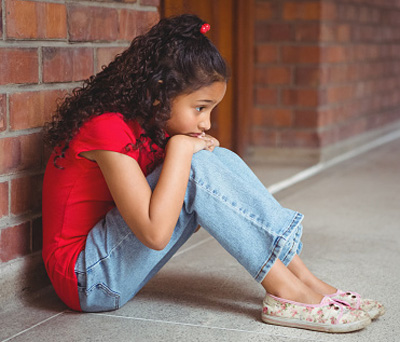
Your eight-year-old daughter seems excessively shy and has trouble separating from you. It’s been a constant struggle for years, and it is not getting better as she gets older. You’re worried she is missing out on activities other kids her age enjoy. She might be suffering from an anxiety disorder — the most common form of mental illness in children.
According to Washington University child and adolescent psychiatrist Chad Sylvester, MD, PhD, “If a child or teenager shows excessive distress when faced with going to school, meeting new people or trying a new activity, that could be a sign of an anxiety disorder.”
A parent’s concern should be tied to the degree to which the child or teenager is distressed. If the distress is significantly impacting the youth’s life to the point he or she is missing out on activities others his or her age enjoy, the parent should talk to the pediatrician or school counselor. This conversation can help determine if the behavior is typical, or if further evaluation might be necessary.
Warning signs are:
- Extreme anxiety or worry
- Excessive shyness
- Avoidance
- Fear of separating from parents
- Sometimes a child or teenager might express fear in other ways, such as a headache or stomach ache
“The first step should be a thorough examination to make sure we completely understand what situations are provoking anxiety in the child or teenager”, says Dr. Sylvester. “Once we’ve established the patient has an anxiety disorder, there is a wide range of treatment options. These include lifestyle changes, therapy or medications – treatment is not a one-size-fits-all.”
Every child or teenager has different emotional needs. Dr. Sylvester says, “The most important thing a parent can do is empathize and acknowledge what their son or daughter may be feeling. Reassurance and validation of emotions are vital.
We also recommend as a general rule not avoiding anxiety-provoking situations unless there is a safety concern. It’s crucial to help the child or teenager to master their anxiety by teaching them techniques to relax and feel confident encountering anxiety-provoking activities.”
It’s important for the child to know that his or her parent cares and is concerned — but at the same time learns to master situations that are anxiety-provoking. The goal of therapy is to provide tools to manage anxiety.
Dr. Sylvester adds, “About 30% of children or adolescents could be diagnosed with an anxiety disorder at some point in their life. Of course, there are varying levels of severity and impairment. It’s easy for someone with anxiety to go unnoticed, especially at school, because they are not necessarily the trouble makers. These kids may be suffering in silence because they usually don’t wear their symptoms on their sleeve.”
Dr. Sylvester is currently seeking 8-12 year old children who are shy, worried and/or clingy as well as children without these symptoms to participate in a study to understand how what subjects pay attention to is related to their symptoms of anxiety and depression.
If you would like, after the completion of the study, you will be mailed the results of your child’s diagnostic interview, including any psychiatric diagnoses that they meet research criteria for. We are also able to provide referrals to community mental health providers based on your child’s specific assessment.
The study involves one phone screen and one to two study visits. Participants will be compensated up to $100 per visit. Please call Caroline at 314-286-0965 for more information about this study.
If you suspect your child or teenager might be suffering from an anxiety disorder, ask your pediatrician for a referral for evaluation at the Washington University Anxiety Disorder Clinic.
Dr. Sylvester sees patients at:
4444 Forest Park, Suite 2100
314-286-1700